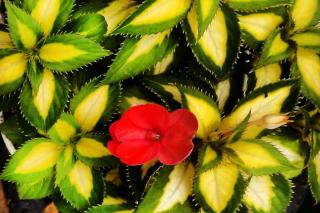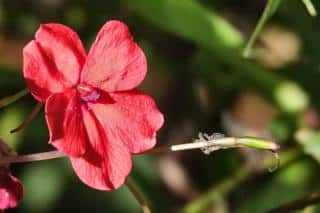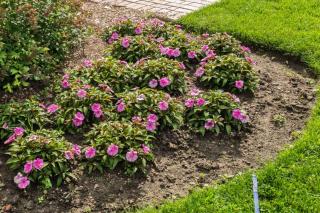Sunpatiens is a plant that has been patented and trademarked. This means it’s forbidden to propagate it without permission. This status refers to cuttings, but seeds aren’t impacted.
- Sakata Seed Corporation is the current owner. It alone authorizes greenhouses and growers to prepare and propagate Sunpatiens flower cuttings.
- Seeds may appear spontaneously on a Sunpatiens; seedlings that sprout are completely different plants and aren’t covered by the legal protections in place. They’re genetically part of the Impatiens family, but they aren’t “Sunpatiens” anymore.
On a practical level, though, if a Sunpatiens has problems, you can salvage a stem and grow a cutting from it to replace the dying one.
Notes:
- Sunpatiens is a group of varieties protected by a plant patent. This is the status that prohibits unauthorized propagation.
- On top of this, Sunpatiens is a trademark. This means the word “Sunpatiens” cannot be used to describe any other plant, such as the offspring of a Sunpatiens.
- As a consequence you should only make such a cutting for personal use and not for financial gain.
Cutting from a Sunpatiens ® plant
You can prepare a cutting from your favorite sunpatiens ® before it dies, it will keep the exact same properties.
Here are the basic steps to prepare the cuttings:
- Length of the stem: 6 inches (15 cm)
- Remove all but the topmost leaves. Shorten these by snipping of the tip (about an inch or 2 cm).
- Dip the cutting in rooting hormone or a natural alternative (honey, aloe vera gel…)
- Sink into a large nursery pot (even the final growing pot directly) with sieved potting mix that has grated charcoal sprinkled over it (prevents fungus and reduces risk of root rot).
- Roots will form very fast, usually within two-three weeks.
 With such a cutting, take care to ensure constant moisture or the blooming may be delayed. Without appropriate moisture control, it might not bloom at all. However, overwatering your cutting will lead to elongated stems with less flowers. Make sure the soil mix drains very well.
With such a cutting, take care to ensure constant moisture or the blooming may be delayed. Without appropriate moisture control, it might not bloom at all. However, overwatering your cutting will lead to elongated stems with less flowers. Make sure the soil mix drains very well.
- The best time to water is when the medium has dried up slightly, just enough to make the leaves sag or wilt a little bit.
- This shows that the plant is focusing its energy on root development which is important.
Where to find Sunpatiens seeds
Stores don’t sell any Sunpatiens seeds, even online.
 However, a few flowers might go to seed on a Sunpatiens. You can collect them for sowing in the following spring. If you yourself don’t have any sunpatiens planted, ask around the neighborhood or visit parks.
However, a few flowers might go to seed on a Sunpatiens. You can collect them for sowing in the following spring. If you yourself don’t have any sunpatiens planted, ask around the neighborhood or visit parks.
Often, when asked politely, people will be more than happy to share. They’ll at least let you check whether their flowers are bearing seeds or not!
- Like all impatiens, Sunpatiens doesn’t produce a lot of seeds. When it does, seedlings may come out quite different from the parent plant because of cross-pollination by other impatiens.
- Seeds produced by any Sunpatiens are never true copies of the original. As such, they often turn out to be a new hybrid! Seed offspring aren’t included in the original patent and trademark.
Above, a seed pod of Impatiens hawkeri, a parent of Sunpatiens.
How to sprout Sunpatiens seeds
Seeds collected from a Sunpatiens need light to germinate. Place them atop the soil mix without covering them up.
 You can either sprinkle the seeds directly on the growing bed (direct sowing) where they’ll sprout and grow, or start them as indoor seedlings 6 to 8 weeks prior to the last frost date in your area.
You can either sprinkle the seeds directly on the growing bed (direct sowing) where they’ll sprout and grow, or start them as indoor seedlings 6 to 8 weeks prior to the last frost date in your area.
At that stage they’ll have grown enough to be transplanted without risk of dying off. For maximum success, check on how to minimize transplant shock.
- There hasn’t been much testing on Sunpatiens seeds to see which parent characteristics transfer to children.
- It may be that hardiness, heat resistance, and blooming are different in children than they were in parents.
- Pay attention to how your new seedlings develop to learn how they cope with heat, drought, or cold weather.
Smart tip about Sunpatiens
Since Sunpatiens is an annual, it’ll die in winter if ever it freezes. Snip a stem off for each plant you’ve got and start a cutting off to extend its life over the cold season. Replace any dead ones with new Sunpatiens from a store to increase the variety of colors and sizes!
Written by Gaspard Lorthiois | Loves helping out, especially when it comes to growing things. Worked in herbal medicine, runs a farm, and dabbles in tech. Master's degree and engineer.


 With such a cutting, take care to ensure constant moisture or the blooming may be delayed. Without appropriate moisture control, it might not bloom at all. However, overwatering your cutting will lead to elongated stems with less flowers. Make sure the soil mix drains very well.
With such a cutting, take care to ensure constant moisture or the blooming may be delayed. Without appropriate moisture control, it might not bloom at all. However, overwatering your cutting will lead to elongated stems with less flowers. Make sure the soil mix drains very well. However, a few flowers might go to seed on a Sunpatiens. You can collect them for sowing in the following spring. If you yourself don’t have any sunpatiens planted, ask around the neighborhood or visit parks.
However, a few flowers might go to seed on a Sunpatiens. You can collect them for sowing in the following spring. If you yourself don’t have any sunpatiens planted, ask around the neighborhood or visit parks. You can either sprinkle the seeds directly on the growing bed (direct sowing) where they’ll sprout and grow, or start them as indoor seedlings 6 to 8 weeks prior to the last frost date in your area.
You can either sprinkle the seeds directly on the growing bed (direct sowing) where they’ll sprout and grow, or start them as indoor seedlings 6 to 8 weeks prior to the last frost date in your area.